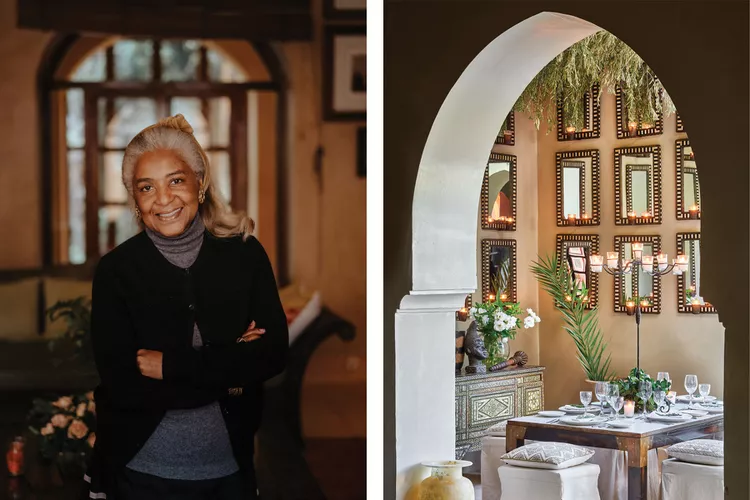Meryanne Loum-Martin and Jnane Tamsna: A Journey of Hospitality in Marrakesh
The consummate hotelier has successfully run a business for two decades and has no plans to slow down.
“This was not the plan. Thirty years ago, I would have never thought that I would end up as an innkeeper,” Meryanne Loum-Martin, Morocco’s sole Black female hotelier, told me. “My friend used to say, ‘So, you left being a Parisian lawyer to be an innkeeper,'” Loum-Martin said, as her laughter filled the cozy parlor of her “inn,” Jnane Tamsna.
Located in the Palmeraie district of Marrakesh, Jnane Tamsna is anything but an inn, and while Loum-Martin is technically its “keeper,” she is also the visionary who has kept the boutique hotel a must-see destination for more than two decades. “When I first came here to the Palmeraie, there was nothing but palm trees as far as the eye could see,” she noted.
Located a roughly 15-minute drive from the bustling and cavernous medina, Jnane Tamsna sprawls over eight acres and boasts 24 rooms in the posh northern end of the Red City. It’s a quiet refuge enveloped in a shade of yellow reminiscent of Morocco’s high-noon sun. Clusters of pink and white bougainvillea burst over its Moorish archways and rooftops. During my visit, I saw hummingbirds cavorting near one of the estate’s five heated swimming pools. There’s only one word that can describe such a scene: paradise.
:max_bytes(150000):strip_icc():format(webp)/pool-jnane-tamsna-MERYANNELOUM1221-581000d2165d4208a92787cd6710beb3.jpg)
Upon my arrival, Loum-Martin was feverishly present and brimming with ideas. It was common to see her walking around the entire space — laptop in tow — surveying the property and taking notes along the way. She chatted with every guest and seemed to know all staff members by their first name.
It’s now the high season in Marrakesh, but because of the pandemic, the city is quieter. “It’s a comfort to begin seeing so many familiar faces again,” said Loum-Martin.
And Jnane Tamsna has indeed seen its fair share of recognizable faces over the years. From actors like Tom Cruise and Yvonne Orji to film directors and photographers like Melina Matsoukas and Peter Lindbergh, celebrities, artists, and aesthetes have flocked to this intimate oasis in the desert.
8 Amazing Black-owned Travel Companies to Know and Support
On one hand, you could say Loum-Martin’s foray into the luxury hospitality world was a bit of a fluke. Born in Côte d’Ivoire to a Senegalese diplomat father and West Indian lawyer mother, her family spent time living in Moscow and London before settling in Paris. Loum-Martin was already a lawyer when she began traveling to Marrakesh in the late 80s in search of a property for the family to build a new vacation home. It was then that she fell in love with the city.
“I was a lawyer, but my heart was never in it. I loved architecture and I knew how to throw great parties,” she said. “I never dreamt this path for myself.”
However, you could also say her drive to be a self-starter was in her blood. “After slavery was abolished, around 1870, the grandfather of my grandmother was freed at the age of 16. Instead of leaving the plantation and heading into the city, he remained and worked for pay as a farmer,” she explained.
Eventually, he saved up enough money to buy the plantation from his former enslaver. He also rented out rooms in exchange for services — for example, providing room and board to someone who could teach him how to read and write. “I am extremely influenced by his life,” she mentioned.
:max_bytes(150000):strip_icc():format(webp)/garden-paths-jnane-tamsna-MERYANNELOUM1221-5472e8950cfd473aa874ff358505c700.jpg)
A New Marrakesh
While the Marrakesh of today is filled with riads and hotels, this wasn’t the case when Loum-Martin recognized the burgeoning market for a small travel business.
She noticed her friends were not interested in staying at big hotels and sought a more curated travel experience — one that came with a lifestyle. “I convinced my parents to buy more land,” she explained. “I thought maybe it would make sense to create a business and buy the land next door, make another house, and establish a statement about a new type of holiday.”
That “new” type of holiday evolved into a boutique hotel with enough style and substance to make guests feel like they were in an environment that was Moroccan but also personal.
:max_bytes(150000):strip_icc():format(webp)/fireplace-salon-jean-cazals-jnane-tamsna-MERYANNELOUM1221-a3ec562e216c4adb8cb8fc99b06697b4.jpg)
In 2001, Loum-Martin purchased another plot of land, 10 minutes away. That’s where Jnane Tamsna sprouted. Although the property changed, the global perspective and intimate feeling remained.
“That fabric is from Senegal,” remarked Loum-Martin, pointing at an intricately printed bedspread in one of the suites. “Oh, and those are from India,” she added, gesturing to the decor elements in a villa.
Each space has a story. However, when you step outside, you cannot help but appreciate the immense beauty of the gardens and landscape. This is the work of Loum-Martin’s ethnobotanist husband, Gary Martin. The two fell in love around the same time the first business launched. Gary, a Michigan native and Berkeley graduate, was in a Zoom discussion with Jane Goodall during my visit. Later, I saw him walking the property with the family dog, Smokey, by his side. Every vegetable served at the hotel comes from one of his nearby gardens.
Additionally, in her esteemed career as an interior designer, Loum-Martin published her first book in 2020, Inside Marrakesh: Enchanting Homes and Gardens — a dazzling guide to the leading design connoisseurs of Marrakesh.
Through political strife in Morocco, the impacts of war, Sept. 11, and now the pandemic, Loum-Martin has learned how to survive in the hospitality industry over the decades.
“People often come to me and ask for advice. Since I have white hair, people think I am wise,” she said, stone-faced as she took a sip of a red berry smoothie before breaking into a girlish laugh. “All I can say is, be an optimist.”




